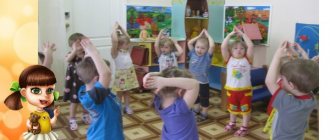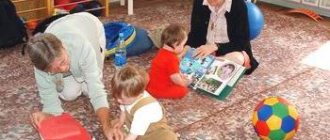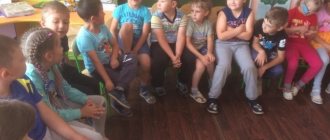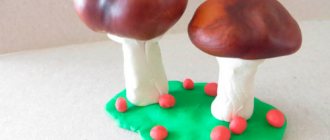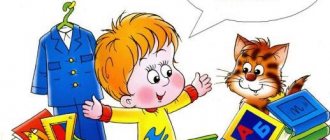Explanatory note
Humanity has accumulated a huge amount of “fairy tale” experience, but in the context of the implementation of the Federal State Educational Standard for Education, material based on fairy tales is not fully used: there is no clear idea of how to use fairy tales and fairy tale “products” more effectively and fully in the educational process.
Fairy tale and fabulous possibilities
Your attention will be presented to the experience of using fairy tales and fairy tale “products” in the educational process. This is not the first year I have been working on the topic “Fairy tales and fairy tale possibilities.” During this time, the author's material was accumulated: fairy tales, fairy tales - tips, sayings, chants, barkers, rituals of entering a fairy tale , word games based on Russian folk tales, riddles, round dance games...Fairy tale material is always accessible and easily applicable in the educational process.
What do I consider fabulous “products”? What fabulous “products” have been accumulated in the process of my practical activities?
Fairytale “products”: sayings; rituals of entering a fairy tale ; fairy tales; fairy spells; verbal games based on fairy tales (Russian folk tales; author's fairy tales) and based on other works of children's writers; fairy tales in GCD; fairy-tale themed round dancing games; outdoor games and relay races based on fairy tales; crosswords based on Russian folk and original fairy tales; riddles based on Russian folk tales; fairy tales - tips; mnemonic tables based on fairy tales.
, fairy tale rituals, or rituals of entering a fairy tale in educational activities . The rituals of entering a fairy tale are not just a mood for GCD, they are magic words behind which something unusual, mysterious is hidden, it is an intrigue - what will happen next? Rituals of entering a fairy tale are used, as a rule, at the beginning of pedagogical activities. Rituals of entering a fairy tale can be used both in educational activities and in other educational and entertainment events (literary quizzes, theatrical performances, entertainment, holidays); Suitable for use with children of different ages (preschool age). Rituals of entering a fairy tale can also be used at the end of events, as a reflection.
The material can be used with any preschool audience (from 3 to 7 years old) .
Rituals of entering a fairy tale
Brook
(You can use blue or blue fabric to imitate a stream.)
A trickle, a trickle into a fairy tale there are many roads. Help us a little - show the bottom the way.
Flower
This flower fills us with magical power from head to toe.
Fairy
(The teacher himself can act as a fairy.)
As soon as the Fairy touches us, the path to a fairy tale will begin immediately.
Princess Frog
I’m ready to share the magical power, You just need to touch it with your hand. Princesses - We touch the frogs with our fingers, We go to a fairy tale.
Breeze
(A table fan can be used.)
Wind, wind, breeze, The path to the land of fairy tales is long. Blow the wind stronger so that you get into the fairy tale on time.
Shell
(You can use a souvenir seashell.)
Shell, shell, tell us in our ears, How is the sea noisy there, what does it say about a fairy tale?
ring
Ring, ring, tell us a word: “How can we plunge into a fairy tale and then return home?”
Cam
We bring the fist with the secret to our ear, turn around three times and find ourselves in a fairy tale (beginning of the event).
Cam
We bring the fist with the secret to our ear, turn around three times, and come home (end of the event).
Track
(You can use a track from physical education equipment.)
Path, path, help a little! You, dear one, don’t go astray, help me get into a fairy tale.
Stone
(You can use decorative stone from an aquarium.)
Stone, stone, you are beautiful, You have great power. We will rub the stone with our hand and immediately find ourselves in a fairy tale.
Pointer
(Spin the pointer on the table.)
Pointer, pointer, give us a hint, Come to help - show the way!
Airplane
(Paper airplane.)
Airplane, the plane is taking off. We will follow next to get to the fairy tale.
Feather
(Any feather, maybe artificial)
The wind brought a feather and we have a question for him: - If we go straight, will we immediately end up in a fairy tale?
Arrow
The arrow flew everywhere, I recognized all the paths. Help, arrow, on the way, How can we get to the fairy tale?
Working with preschoolers on staging a play. Methodological recommendations
The methodological recommendations include the main stages of working with preschoolers on staging a play and developing scripts for performances.
The recommendations are addressed to the heads of theater associations and additional education teachers.
Working with preschoolers on staging a play
In modern society, the social prestige of intelligence and scientific knowledge has increased. Associated with this is the desire to give children knowledge, to teach them to read, write and count, and not the ability to feel, think and create.
There is an important problem that worries teachers. According to data, during the period of a child’s psychological adaptation to school, 69% of first-graders experience fears, breakdowns, and lethargy, while others, on the contrary, become loose and fussy, lack voluntary behavior skills, and have insufficiently developed memory and attention. The shortest way to emotionally liberate a child, relieve tension, teach feelings and artistic imagination is the path through play, fantasy, and writing. Theatrical activities can provide all this.
It is dramatization “based on an action performed by the child himself that most closely, effectively and directly connects artistic creativity with personal experiences.” (L.S. Vygotsky).
Creating a play with children is a very exciting and rewarding activity. Joint creative activity involves even insufficiently active children in the production process, helping them overcome shyness and inhibition.
When preparing for a performance, try to follow a few basic rules:
- do not overload children;
- do not impose your opinion;
- provide all children with the opportunity to try themselves in different roles.
Children's first meeting with a play or dramatization should be emotionally rich in order to awaken interest in the work ahead. As a rule, the material for stage implementation is fairy tales, which provide “an unusually bright, broad, multi-valued image of the world.” The world of a fairy tale with its wonders and secrets, adventures and transformations is very close to a child. A fairy tale awakens in children compassion, a desire to understand another person, a sense of complicity, justice, a desire to do good and fight evil.
When choosing material for dramatization, take into account the age capabilities, knowledge and skills of children, but at the same time you need to enrich their life experience, awaken interest in new knowledge, and expand their creative capabilities.
The Kuklyandiya theater association has been open to boys and girls since 2003. At first these were teenagers and high school students. Since 2006, the team has been replenished with younger schoolchildren, and since 2009, the team has expanded with preschool children. In this methodological recommendation, I would like to pay attention to the main stages of working with preschoolers on staging a play or dramatization.
The main stages of working on the performance:
- Selecting a play and discussing it with children.
- Dividing the play into episodes and retelling them for children.
- Work on episodes in the form of sketches with improvised text.
- Search for an image (defining the character of the hero, manner of moving, speaking).
- Search for mise-en-scène (musical and plastic solutions for episodes, staging dances). You can create sketches of scenery and costumes with your children.
- Work on the text: proposed circumstances and motive for the characters’ behavior.
- Work on the expressiveness of speech and the authenticity of behavior in public conditions, consolidating individual mise-en-scenes.
- Rehearsals based on paintings with elements of scenery and props (possibly conditional), with musical accompaniment.
- Rehearsal of the entire play - run-through (scenery, props, costume).
- Premiere of the play. Discussion.
- Reruns. Preparing an album with photographs.
The first stage of working on a play is related to its selection. When preparing dramatizations based on folk and original fairy tales, you can have a conversation about the life and way of life of people of that time (what they dressed in, what they ate, how they communicated, what customs they observed). Listening to music, artistic illustration. You can watch films, they help you feel the atmosphere of fabulous events. And it broadens your horizons. Activates cognitive interest.
It is useful for the development of imagination, the ability to fantasize, to invite children to compose the lives of the characters before the play begins (i.e., a fragment of life), helping with a variety of leading questions. Thus, we unobtrusively lead children to the ability to analyze and search for a character’s image.
The second stage involves dividing the play into episodes (pieces). Children retell each episode, complementing each other, and come up with a name.
The third stage is working on individual episodes in the form of sketches with improvised text. At first, the most active children become participants, but we must strive, without forcing, to involve all members of the team in this process. From the beginning, children are hampered by a relatively small vocabulary, which makes it difficult to conduct a dialogue, but feeling the support (hint) of the teacher, children begin to act more naturally and confidently, and their speech becomes more varied and expressive.
The fourth stage is the search for an image, the work is first built as a conversation; discussion of the character of the hero, manner of speaking, moving, We listen to all the options, who thinks what? Why? For what? etc.
All children take part in the discussion, but the teacher’s task is to easily lead to the right decision, explaining why and how. Next, we come up with plastic sketches (gait, manner) and demonstrate them. At this stage, you have to talk a lot about the actor's work and the role. That there are no bad roles. Very often children do not want to play negative characters, so it is necessary to explain to children that the actor’s task is to show these negative character traits and behavior of the hero for moral purposes. And one more technique that you can use is to look for positive qualities in a negative character, and negative qualities in a positive one.
The fifth stage is the search for mise-en-scène. Creation of sketches of scenery and costumes.
Mise-en-scene is the placement of actors, things, various things (props, decoration elements) on the stage at certain moments of the performance. At this stage, young (already) actors learn to act . The teacher’s task is to help find the necessary (according to the logic of the action) gesture, movement, action and lead the child to this action, so that he can really live through some moment so that the movement, action is alive and justified, and not imposed by an adult. We lead the child to this, based specifically on his life experience, analyzing his life situations, and what would you do..., if...? and how would you say... if...?). So, as you can see, at this stage children are faced with Stanislavsky’s “magical: if…”, and this leads to the ability to transform.
Also at this stage, children are introduced to the musical works that will be performed in the performance. And bright musical images help children find the appropriate plastic solution; at first they simply improvise to the music, then move, turning into a specific character.
At the same time, they learn to create sketches, make drawings of individual paintings, images according to a creative plan, selecting colors in accordance with their imagination.
The sixth stage is a gradual transition to the text of the play. During rehearsals, the same passage is repeated by different performers many times, which allows children to quickly learn almost all the roles. During this period, the proposed circumstances of each episode are clarified (where? when? at what time? why? why?) and the motives for the behavior of each character are emphasized (for what? for what purpose?)
The seventh stage begins work on the role. Already knowing that, based on personal emotional experience and memory, the child remembers a situation in his life when he experienced feelings similar to those of the characters in the play. Do not impose the logic of another person’s actions on young actors. Children can propose the most successful, in their opinion, invented mise-en-scène and we consolidate them.
At this stage, achieve expressiveness and clarity of speech, identify the speech characteristics of the characters. Each has their own style (smoothly, drawing out words, another - very quickly, emotionally, a third - slowly, confidently, etc.)
The eighth stage is rehearsal for paintings in different compositions. During rehearsal, make sure that children do not repeat the poses, gestures, and intonations of other performers, but look for their own variations. Learn to place yourself on the stage (logically), without getting confused, without overlapping each other (the law of the stage). Any discovery, a new successful solution should be celebrated and encouraged, taught not to be afraid, but to skillfully work with props, play with the scenery, because the main thing on stage is the action.
The ninth stage is the shortest in time. During this period, rehearsals of the entire play take place. If before at rehearsals some of the scenery and props were conventional, now we use props, scenery, and costumes prepared for the performance, which help in creating the image.
Rehearsals are accompanied by musical accompaniment, the tempo of the performance is specified, the length of individual scenes or, conversely, excessive haste and crumpledness. Assign responsibilities in preparing props and changing scenery.
The tenth stage - the premiere of the performance, is also a dress rehearsal because The first viewer comes to the premiere.
A premiere is always excitement, bustle, and, of course, an upbeat, festive mood. In practice, children begin to understand what the collective nature of theatrical art is, how the success of the performance depends on the attention and responsibility of each performer (prop master, sound engineer, prop man, costume designer, etc.). Applause!
There is no point in holding a discussion immediately after the presentation. Young actors are still too excited and will not be able to evaluate their successes and failures. But the next day, in a conversation, you can find out how critically they are able to treat their own performance by answering questions about what was good and what was not, children learn to evaluate sincerity and truthfulness on stage, note the expressiveness and resourcefulness of behavior on stage, noting expressiveness and resourcefulness of individual performers.
And the teacher’s task is to direct the conversation in the right direction with his questions, trying to point out the main mistakes and shortcomings, but at the same time praise and note the successful and interesting moments of the speech.
And the final stage is reruns of the performance. The statement that children get tired of playing the same thing over and over again is incorrect. This will get boring if everything in the play is programmed and the young actors only blindly carry out the director’s will. And if children understand what they should do on stage, then try to act differently each time, then this is already an element of creative improvisation. And this is the most precious thing for a teacher, as for the leader of a theater group, i.e. The task that I set for myself has been completed - to reveal a creative individuality (to teach me to look for my own expressive means, and not to imitate others), capable of authentically, organically acting in public conditions (stage).
Below are the developments of scripts for various performances.
The full version of the work is available.
Summary of direct educational activities on speech development
“Fairytale walk” for children of senior preschool age
Goals:
Training tasks:
- develop children's moral and ethical vocabulary;
- activate children's vocabulary on the topic: “Wild animals”;
- practice grammatical categories (diminutive forms of nouns);
- learn to select words with the same root;
- continue to teach children to use definitions in speech.
Developmental tasks:
- develop visual and auditory perception;
- improve the sound side of speech in the areas of pronunciation, perception and expressiveness;
- develop coordination of speech with movement.
Educational tasks:
- develop skills of cooperation and mutual understanding;
- teach in conveying an emotional state using various expressive means.
Material for the lesson:
- ICT (interactive whiteboard; laptop; presentation - animal ears: bear, fox, hare, wolf);
- animal costumes: fox, hare;
- fairy tales and cut-out pictures for them: “Kolobok”, “Teremok”, “Turnip”, “Zayushkina’s Hut”, “Three Bears”, “Wolf and Seven Little Goats”;
- riddle about the fairy tale “The Three Bears”;
- pictures “Animal family” (bear - she-bear - little bear, etc.);
- audio recording “sounds of the forest”;
- pictogram for the story “The Cat and the Bee”.
Preliminary work:
- reading Russian folk tales;
- guessing riddles about animals;
- looking at pictures on the topic: “Wild animals”;
- learning dialogue poems.
GCD move
Educator. The lesson begins with a fabulous ritual. Now you and I will go for a walk. This walk is not simple, but fabulous. I propose to start our walk with magic words, with the help of which you and I will find ourselves in a fairy tale.
We will spin, We will spin, And we will soon meet with the fairy tale.
Children repeat these words in chorus
Educator . So you and I found ourselves in a fairytale forest. What kind of fabulous animals do you think we can meet in this forest?
Children's answers:
- you can meet a fox in the forest;
- you can meet a hare in the forest;
- You can meet fabulous animals in the forest.
Educator.
A wizard lives in the forest - He does everything wrong! It’s not for nothing that they called him the Nasty Wizard!
I.F.Kugaevskaya
Exercise 1.
Enchanted pictures.
The evil wizard Nasty said today: “Whoever comes to the forest today will not find anyone here.” I got up early in the morning and bewitched all the animals. You have to try really hard to figure this out.
I.F.Kugaevskaya
Pictures depicting animal ears (hare, wolf, bear, fox, squirrel) are displayed on the interactive board (as you guess).
Children guess and name the “enchanted” animals by their ears.
Children's answers:
- these are the ears of a hare;
- these are squirrel ears, etc.
Task 2.
Good and evil are different animals.
The evil wizard Nasty has done everything wrong again: Good, evil, other animals... He mixed them all up, guys. You have to try again to figure this out. We will try and we can figure it out.
Educator . Remember these words: “kind”, “evil”, “round”, “big”, “fast”, “cunning”, “thrifty”. The teacher names the fairy-tale hero, and the children choose a definition (wolf - evil; fox - cunning, etc.).
Children's answers:
- squirrel – thrifty;
- hare - shy;
- bear - clubfoot, etc.
Task 3.
Mixed-up fairy tales.
The enemy mixed up all the fairy tales. We don't expect any help from him. We’ll sort out all the pictures and find the fairy tales we need.
I.F.Kugaevskaya
Children match cut-out pictures to a plot picture from a fairy tale; fairy tales “Kolobok”, “Teremok”, “Three Bears” and others - at the teacher’s choice.
Children's answers:
- this fairy tale is called “Kolobok”;
- this fairy tale is called “Zayushkina’s Hut”;
- this tale is called “The Cat, the Rooster and the Fox,” etc.
Warm up.
We will invite the forest people into our friendly round dance. The children are walking in a circle. The bunnies have come running and are jumping on the lawn. The children are jumping, pretending to be hares. And the master foxes are spinning in the dance. The children spin around in place. The squirrels start dancing along with them. Children do squats (springs). But then the Nasty came, They all shouted like this: - Oooh! Children shout: Oooh!
I.F.Kugaevskaya
Task 4.
Riddle about the fairy tale “Three Bears”
Near the forest on the edge of the forest, three of them live in a hut. There are three chairs and three mugs, Three beds, three pillows. Guess without a hint, who are the heroes of this fairy tale?
Children's answers:
- This tale is called "The Three Bears".
Task 5.
Name the family.
We have to tell you about animal families. Now we will call dad, mom and child.
Children name each of the family of animals: for example: bear - she-bear - bear cub, etc.
Children's answers:
- wolf-wolf-cub;
- fox-fox-little fox;
- hare-hare-hare, etc.
Task 6.
Dialogue “Conversation between the fox and the hare.” The poem is narrated by two children. Children are dressed in fox and hare costumes.
The bunny is not friends with Foxy. As soon as he sees him, he trembles all over. The bunny sees Little Fox, turns around and runs away.
Fox. Hello, Bunny! Where have you been? Bunny. I went to get a fur coat. Fox. Where did you buy the fur coat? Bunny. Yes, the hedgehog made me a fur coat. Fox. Come on, come closer! Bunny. Oh, Lisa, don't come closer! Fox. Come, I'll take a look. Bunny. No, Lisa, I'm leaving!
I.F.Kugaevskaya
